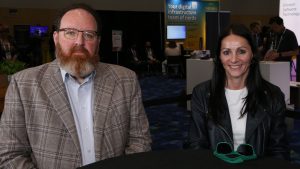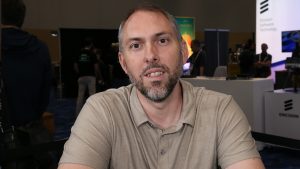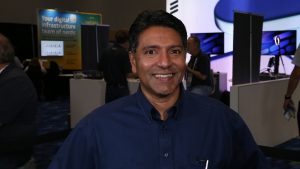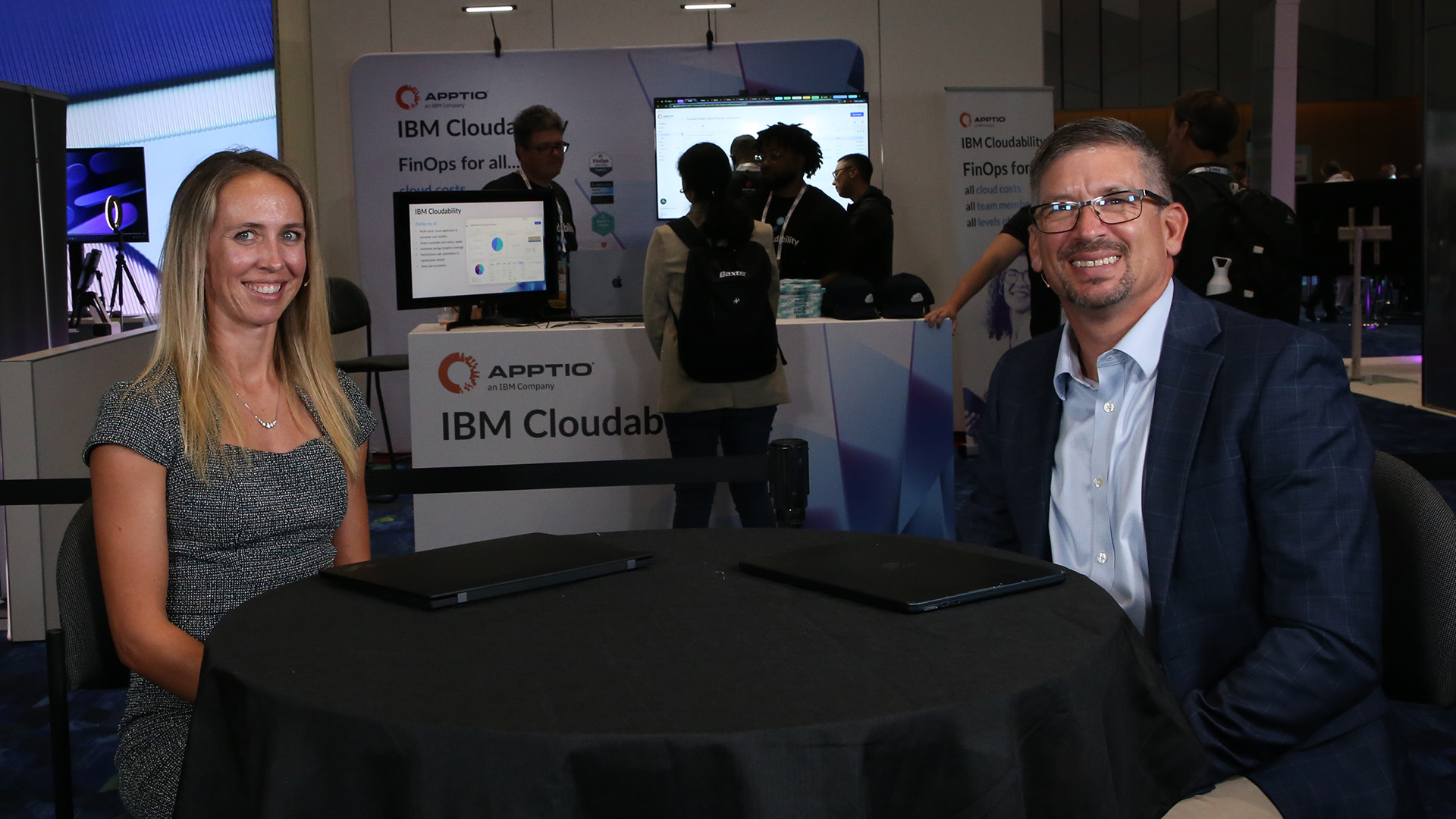Beyond uniting developers under shared ideologies, goals and pain points, Open Source Summit North America ignited conversations at the intersection of code, community and change.
TheCUBE goes live with insights at Open Source Summit NA.
Against the backdrop of a rapidly evolving tech landscape, this year’s edition serves as a reality check and vision board, showcasing how open-source tech is tackling today’s toughest questions: Who’s driving governance in a decentralized world? How can AI innovation remain open and safe? Where do policy, compliance and sustainability fit into the developer’s roadmap?
“Modernization is a treadmill — it’s continuously happening,” said Paul Nashawaty (pictured, right), practice lead for app development and modernization at theCUBE Research. “The thing that we have to understand is that governance, compliance and regulations need to be put into place. We found that was a big part of the concern from organizations around how organizations are moving forward with modernization, with heritage applications and bridging the gap to new. They’re using technologies like agent technologies to make the connections to rapidly accelerate application development.”
Nashawaty and fellow analyst Sam Weston (pictured, left) were on the ground at Open Source Summit North America to capture the pulse of these critical conversations. Across 13 interviews with theCUBE, thought leaders, engineers and enterprise contributors shared thoughts on the direction of open source — from the Linux kernel to the outer edges of AI, edge computing and safety-critical segments. (* Disclosure below.)
Here’s a breakdown of the event’s noteworthy segments:
1. Open-source tech gets an AI power-up
With AI as its accelerant, open source is exploding. Fresh research from the recent AppDev Done Right Summit shows a marked shift from static modernization to an ongoing AI-powered journey, according to Nashawaty.
“AI is happening at such a record clip that the innovation has to keep happening very quickly, and organizations are adopting this information rapidly,” he said in an analysis segment during the event. “That’s why I think that we’re seeing the kind of convergence between the technology and the tech stacks and what we’re seeing again here at the Open Source Summit.”
Sixty-one percent of organizations are investing in AI platforms, and generalists, aided by agents, are closing the skills gap, Nashawaty added. Yet with speed comes risk. Compliance, security and observability are rising concerns. As open-source tech becomes the backbone of innovation, organizations must balance agility with governance to thrive in a fast-evolving digital landscape.
Check out theCUBE’s complete interview.
2. The real ROI of open-source tech
Open-source technologies are already delivering returns that go beyond immediately quantifiable metrics, according to Frank Nagle, advising chief economist at The Linux Foundation. All factors considered, there’s a potential $9 trillion industry-wide economic impact as emerging AI tech increasingly integrates into open-source stacks.

Linix Foundation’s Frank Nagle explores open-source ROI with theCUBE.
“That’s an underestimate of the true value because we’re only looking at the packages that are baked into other applications or other things like that,” he said in an interview with theCUBE. “We’re not looking at some of the more standalone open-source projects as well, which add a lot of value.”
Additionally, startups contributing back to open-source tech see up to 2x productivity gains, he added. As AI transforms dev workflows and budgets, however, there’s a need to balance regulation, collaboration and contribution. The message is clear: Open source isn’t just free code, it’s a strategic investment with transformative returns.
Don’t miss the full interview on theCUBE.
3. Chronosphere launches Logs 2.0 to tame observability chaos
In alignment with the ethos of streamlining operations, Chronosphere Inc. recently unveiled Logs 2.0, a breakthrough in log management designed for cloud-native observability. The platform helps enterprises combat ballooning telemetry data — growing 250% year over year — by filtering out useless data and optimizing what matters, according to Martin Mao, co-founder and chief executive officer of Chronosphere.
“It’s a brand new launch of a brand new product for us,” he said during an interview with theCUBE. “It is an end-to-end log management capability, so you can imagine our ability to ingest and store logs natively into the product, and use logs along with the other data sources like metrics and traces.”
With integrated metrics, logs and traces, Chronosphere delivers a unified user experience focused on root-cause analysis, not just alert fatigue. New tools such as the usage analyzer and Calyptia-powered pipelines slash data volumes by up to 90%, Mao added.
Catch the entire conversation on theCUBE.
4. How CRA is rehaping open-source tech security
Global impact starts with local action. Embodying that philosophy is Europe’s Cyber Resiliency Act, with its enforcement compliance kicking off in late 2017.

OpenSSF’s Crob Robinson discusses open-source security with theCUBE.
“Part of the mission of our foundation is we’re trying to provide education and awareness,” said Crob Robinson, chief security architect of OpenSSF, in an interview with theCUBE. “This is what the facts of the law are, this is what actions you’re going to need to take … but really, the burden of the compliance falls on software manufacturers.”
Open-source tech maintainers can proactively align with frameworks like the OpenSSF Security Baseline to meet CRA requirements and boost security maturity, according to Robinson. With global markets such as India, China and Australia following suit, CRA compliance isn’t optional — it’s essential for market access, reputation and survival in a hyperconnected software world, according to Robinson.
Hear the full story on theCUBE.
5. FAIR Package Manager solves open-source supply chain risks
Digital products have often struggled with streamlining software chains to filter vulnerabilities. Answering that difficulty is the FAIR Package Manager — an initiative from The Linux Foundation to fix WordPress’ supply chain vulnerabilities without fracturing its massive community, according to Joost de Valk, partner at Emilia Capital GmbH.
“It’s meant as a replacement for wordpress.org for the reason that we’ve had a couple of incidents over the last couple of years and more recently, the end of last year, where it was made very clear that we had a supply chain security problem in the WordPress space,” he said in an interview with theCUBE.
FAIR (federated and independent repositories) decentralizes plugin and theme distribution, offering enhanced security, GDPR compliance and commercial plugin support. With backing from The Linux Foundation, it aims to become the de facto standard for WordPress and possibly beyond, de Valk added.
Watch theCUBE’s full sit-down.
6. Inside the open-source push to standardize the future
Agentic AI has risen to prominence as one of the tech’s key innovation areas today. With The Linux Foundation’s A2A protocol and Amazon Web Services Inc.’s open-source Strands Agents SDK, a future of interoperable, secure and specialized multi-agent systems is taking shape, according to Antje Barth, principal developer advocate at AWS.

AWS’ David Nalley and Antje Barth discuss open-source standardization with theCUBE.
“If you look into the future part of this, where this ends up is a world where you have agents performing a lot of specialized tasks and you need standards and protocols to build those systems to make sure they communicate in an efficient way,” she said in an interview with theCUBE.
Agents now autonomously plan, reason and act across toolchains, augmented by developer-driven validation. The consensus? Agentic AI is here, it’s accelerating fast, and open-source tech is its connective tissue.
Check out theCUBE’s complete interview.
7. How Logs 2.0 redefines observability efficiency
Logs 2.0 marks the expansion of Chronosphere’s observability platform to include cost-efficient, insight-driven log management. Logs are the essential glue in tracing and troubleshooting, and the platform’s unified, open-source-friendly solution helps dev teams cut through noise, reduce data overload and optimize telemetry value, according to Alok Bhide, head of product innovation at Chronosphere.
“Chronosphere as a product is excellent at controlling your data volumes and help giving you insight and data volumes,” he said in an interview with theCUBE. “We hadn’t done that for logs yet, so what we’re launching is the ability to do that with logs now … to control data volumes and get insights into your data volumes with logs.”
Don’t miss the full interview on theCUBE.
8. OpenSearch 3.1 powers AI-driven observability and real-time search
OpenSearch is evolving forward, and its 3.1 release signals an evolution toward underpinning gen AI and agentic applications. Key updates include a 10x performance boost, enhanced hybrid and vector search and real-time analytics capabilities, according to Mukul Karnik, general manager of Search Services at AWS.
“The world is moving towards agentic and agentic AI, and so we launched support from oral context protocol and we launched different tools that now leverage the power of the search and analytics capabilities of OpenSearch,” he said in an interview with theCUBE.
Check out theCUBE’s complete interview.
9. Linux Foundation and CNCF outline their open-source tech vision
Alongside the Cloud Native Computing Foundation, The Linux Foundation sees the future of open source as having tighter integration across open-source tech ecosystems.

The Linux Foundation’s Jonathan Bryce discusses the larger open-source vision.
Reaching that goal will require several milestones, one of which is aligning foundational projects such as OpenStack and Kubernetes to improve interoperability, developer experience and global collaboration, according to Jonathan Bryce, executive director of cloud and infrastructure at The Linux Foundation.
“How can we make sure that at the end of the day our members are able to build really tightly integrated products and services, and take those to market and our users have a good experience when they are implementing these projects in production?” he said in an interview with theCUBE.
Don’t miss the full interview on theCUBE.
10. Taming Kubernetes costs with Kubecost
Operational overheads in running Kubernetes workloads can often expand like a forest fire. Given FinOps’ importance to cloud modernization, Kubecost gives teams the visibility into container-level spend, helping them right-size Kubernetes workloads before overspending spirals, according to Sean Pomeroy, solutions engineer for IBM Kubecost.
“If you lay the groundwork ahead of time, you set yourself up for success much earlier in the game,” he said in an interview with theCUBE. “A lot of the times the issues that we run into are people just don’t know what they don’t know. They don’t know about the infrastructure — they don’t know their costs without some metadata to help them align their cost to different cost centers and business units.”
Catch the entire conversation on theCUBE.
11. Bridging the talent gap in the AI age
AI’s rise has reshaped the industry conversation around talent gaps in tech. And while AI reshapes the developer role and boosts productivity, it also widens the gap in foundational cloud-native skills.

Linux Foundation’s Clyde Seepersad discusses the open-source tech talent gap with theCUBE.
Organizations must, therefore, rethink talent strategies — upskilling, rotating roles and prioritizing business context over rigid job titles, according to Clyde Seepersad, senior vice president and general manager of education at The Linux Foundation.
“In the 60 years post-World War II, productivity growth was 2.5%,” he said in an interview with theCUBE. “Since 2000, it’s been more like 1.4%. Having more productivity is a good thing. Figuring out how to use AI to do that is a good thing. Figuring out how to do that in the context of our talent strategy is an important thing and one that I think not enough people are talking about.”
Hear the full story on theCUBE.
12. PyTorch’s push for AI licensing standards
PyTorch has undergone a profound evolution, culminating in the launch of the open model definition for the Web. As AI development accelerates, OpenMDW — a permissive license specifically created for machine‑learning models — aims to simplify licensing by covering the full spectrum of AI artifacts (code, data and documentation) under one permissive, standardized license, according to Matt White, executive director of the PyTorch Foundation and general manager of AI at The Linux Foundation.
“We’ve identified 16 different components that fall in the categories of code documentation or data,” he said in an interview with theCUBE. “We look at model weights as being high-dimensional data, and model architectures are actually a blend of software and configuration. There’s all these sorts of adjacent components as well that you don’t find in conventional software.”
Designed to foster innovation, reduce legal risk and support downstream developers, OpenMDW helps organizations safely build on open models. With PyTorch expanding its community and project base, the future of open AI looks fast, flexible and collaborative.
Watch theCUBE’s full sit-down.
13. The 75x faster runtime that’s reshaping polyglot app development
In a move to design a Java-first alternative to Node, Elide debuts as a fast, GraalVM-powered runtime promising performance gains over Node.js. It offers native speed, memory safety and seamless polyglot support while running Python, Ruby, JavaScript and Java together with zero overhead, according to Sam Gammon, co-founder and chief executive officer of Elide. It also enables faster CI/CD pipelines, major cloud cost savings and easier cross-team collaboration.
“AI is going to be local and sovereign — when we get there,” he said in an interview with theCUBE. “I think businesses are going to have their own AI in-house. They’re not going to be paying Anthropic or OpenAI for bazillions of dollars just to run their business. To get there, we need to evolve on the runtime side.”
Check out theCUBE’s complete interview.
Here’s the complete video playlist from News’s and theCUBE’s coverage of Open Source Summit 2025:
https://www.youtube.com/watch?v=videoseries
(* Disclosure: TheCUBE is a paid media partner for the Open Source Summit. The sponsors of theCUBE’s event coverage do not have editorial control over content on theCUBE or News.)
Photo: News
Support our open free content by sharing and engaging with our content and community.
Join theCUBE Alumni Trust Network
Where Technology Leaders Connect, Share Intelligence & Create Opportunities
11.4k+
CUBE Alumni Network
C-level and Technical
Domain Experts
Connect with 11,413+ industry leaders from our network of tech and business leaders forming a unique trusted network effect.
News Media is a recognized leader in digital media innovation serving innovative audiences and brands, bringing together cutting-edge technology, influential content, strategic insights and real-time audience engagement. As the parent company of News, theCUBE Network, theCUBE Research, CUBE365, theCUBE AI and theCUBE SuperStudios — such as those established in Silicon Valley and the New York Stock Exchange (NYSE) — News Media operates at the intersection of media, technology, and AI. .
Founded by tech visionaries John Furrier and Dave Vellante, News Media has built a powerful ecosystem of industry-leading digital media brands, with a reach of 15+ million elite tech professionals. The company’s new, proprietary theCUBE AI Video cloud is breaking ground in audience interaction, leveraging theCUBEai.com neural network to help technology companies make data-driven decisions and stay at the forefront of industry conversations.








